Johnston Research Group
Department of Physics and Astronomy, The University of Tennessee, Knoxville
Pair localization and beyond Hubbard model pairing in cuprate ladders
 H. Padma et al., Phys. Rev. X 15, 021049 (2025);
A. Scheie et al., arXiv:2501.1026 (2024);
—
The Hubbard model has traditionally been viewed as the minimal model for
describing electron interactions in cuprate physics. However, recent
advanced numerical studies have indicated a lack of a superconducting
ground state in two dimensions (2D). Simultaneously, angle-resolved
photoemission experiments have revealed the existence of non-local
interactions in cuprate chains. We case further evidence of beyond Hubbard
physics in two separate and complementary studies of the prototypical
ladder cuprates
Sr14-xCaxCu24O41
using resonant inelastic x-ray scattering
(RIXS) and inelastic neutron scattering (INS). Our findings thus uncover
non-local interactions in the quasi-one-dimensional superconducting
cuprates. By integrating density matrix renormalization group (DMRG)
simulations with RIXS measurements on the x=0 samples and INS measurements
on the x = 11.5 samples of the
Sr14-xCaxCu24O41 series, we demonstrate that
the low-energy magnetic excitations are consistent with a significant
contribution from a nearest-neighbor attractive interaction, V.
Furthermore, we show that this interaction enhances pairing and
localization of the doped holes, extending beyond the traditional
description provided by the Hubbard model. Our results pave the way for new
research into cuprates and other high-temperature superconductors, focusing
on the origins and effects of non-local interactions.
H. Padma et al., Phys. Rev. X 15, 021049 (2025);
A. Scheie et al., arXiv:2501.1026 (2024);
—
The Hubbard model has traditionally been viewed as the minimal model for
describing electron interactions in cuprate physics. However, recent
advanced numerical studies have indicated a lack of a superconducting
ground state in two dimensions (2D). Simultaneously, angle-resolved
photoemission experiments have revealed the existence of non-local
interactions in cuprate chains. We case further evidence of beyond Hubbard
physics in two separate and complementary studies of the prototypical
ladder cuprates
Sr14-xCaxCu24O41
using resonant inelastic x-ray scattering
(RIXS) and inelastic neutron scattering (INS). Our findings thus uncover
non-local interactions in the quasi-one-dimensional superconducting
cuprates. By integrating density matrix renormalization group (DMRG)
simulations with RIXS measurements on the x=0 samples and INS measurements
on the x = 11.5 samples of the
Sr14-xCaxCu24O41 series, we demonstrate that
the low-energy magnetic excitations are consistent with a significant
contribution from a nearest-neighbor attractive interaction, V.
Furthermore, we show that this interaction enhances pairing and
localization of the doped holes, extending beyond the traditional
description provided by the Hubbard model. Our results pave the way for new
research into cuprates and other high-temperature superconductors, focusing
on the origins and effects of non-local interactions.
Identifying and quantifying Su-Schrieffer-Heeger-like interactions with RIXS
 D. Banerjee
et al., arXiv:2412.15981 (2024) —
Su-Schrieffer-Heeger (SSH)-like electron-phonon (e-ph) models have gained
recent interest due to their ability to host several novel effects. This
model’s unique electron-phonon interaction, where the atomic motion
modulates the electronic hopping integrals, makes it different from the
well-known Holstein model. Thus, the community needs experimental
protocols to identify signatures of SSH interaction in quantum materials.
On this front, Resonant inelastic x-ray scattering (RIXS) has shown
promising results in its ability to access spin, charge, orbital, and
lattice degrees of freedom. In this work, we identify signatures of SSH
interaction in RIXS spectra, which makes the path for experimental
verification. Specifically, we calculate RIXS spectra on an extended
lattice using the numerically exact density matrix renormalization group
(DMRG) method. Our results show the presence of intrinsic coupling
between phonon and collective spin and/or charge excitations in the
system, which can not be understood with the widely used single-site
framework. We also identify signatures of SSH interaction in RIXS spectra
for future experimental verification.
D. Banerjee
et al., arXiv:2412.15981 (2024) —
Su-Schrieffer-Heeger (SSH)-like electron-phonon (e-ph) models have gained
recent interest due to their ability to host several novel effects. This
model’s unique electron-phonon interaction, where the atomic motion
modulates the electronic hopping integrals, makes it different from the
well-known Holstein model. Thus, the community needs experimental
protocols to identify signatures of SSH interaction in quantum materials.
On this front, Resonant inelastic x-ray scattering (RIXS) has shown
promising results in its ability to access spin, charge, orbital, and
lattice degrees of freedom. In this work, we identify signatures of SSH
interaction in RIXS spectra, which makes the path for experimental
verification. Specifically, we calculate RIXS spectra on an extended
lattice using the numerically exact density matrix renormalization group
(DMRG) method. Our results show the presence of intrinsic coupling
between phonon and collective spin and/or charge excitations in the
system, which can not be understood with the widely used single-site
framework. We also identify signatures of SSH interaction in RIXS spectra
for future experimental verification.
Theory of electron-phonon interactions in extended correlated systems probed by resonant inelastic x-ray scattering
 J. Thomas
et al., Physical Review X 15, 021030 (2025) — Quantum
materials demonstrate a range of novel phenomena that stem from the
interplay of various degrees of freedom. Resonant inelastic x-ray
scattering (RIXS) offers unique insights into this realm by providing
experimental access to spin, charge, orbital, and lattice degrees of
freedom. However, despite its versatility, our understanding of how RIXS
probes lattice excitations has been constrained by the limitations in
accurately modeling this process. This study establishes a new framework
for interpreting lattice excitations in RIXS experiments. It employs
a non-perturbative numerical approach, specifically the density matrix
renormalization group, to compute the RIXS response on extended lattices.
This work provides a comprehensive view of how RIXS excites the lattice and
clarifies the types of information that one can and cannot extract from
these experiments. Notably, we discover that much of the conventional
wisdom surrounding lattice excitations in these experiments applies only in
specific limiting cases. As RIXS capabilities and resolution continue to
improve, our work lays the groundwork for a more realistic analysis of new
experiments on a variety of materials, including high-temperature
superconductors, quantum magnets, and correlated insulators.
J. Thomas
et al., Physical Review X 15, 021030 (2025) — Quantum
materials demonstrate a range of novel phenomena that stem from the
interplay of various degrees of freedom. Resonant inelastic x-ray
scattering (RIXS) offers unique insights into this realm by providing
experimental access to spin, charge, orbital, and lattice degrees of
freedom. However, despite its versatility, our understanding of how RIXS
probes lattice excitations has been constrained by the limitations in
accurately modeling this process. This study establishes a new framework
for interpreting lattice excitations in RIXS experiments. It employs
a non-perturbative numerical approach, specifically the density matrix
renormalization group, to compute the RIXS response on extended lattices.
This work provides a comprehensive view of how RIXS excites the lattice and
clarifies the types of information that one can and cannot extract from
these experiments. Notably, we discover that much of the conventional
wisdom surrounding lattice excitations in these experiments applies only in
specific limiting cases. As RIXS capabilities and resolution continue to
improve, our work lays the groundwork for a more realistic analysis of new
experiments on a variety of materials, including high-temperature
superconductors, quantum magnets, and correlated insulators.
Fluctuating charge-density-wave correlations in the three-band Hubbard model
 P. Mai et al., PNAS 121, e2408717121 (2024) —
We performed large-scale determinantal quantum Monte Carlo simulations of
the three-band Hubbard model at unprecedentedly low temperatures. Our
study revealed fluctuating spin and charge modulations, and we
systematically analyzed their evolution with temperature, charge transfer
energy, and doping. Notably, we found that the incommensurability of the
charge modulations is decoupled from that of the spin and decreases with
hole doping. This behavior aligns with experimental observations across
a wide range of cuprate families at high temperatures and contrasts the
modulation patterns seen in the single-band Hubbard model.
P. Mai et al., PNAS 121, e2408717121 (2024) —
We performed large-scale determinantal quantum Monte Carlo simulations of
the three-band Hubbard model at unprecedentedly low temperatures. Our
study revealed fluctuating spin and charge modulations, and we
systematically analyzed their evolution with temperature, charge transfer
energy, and doping. Notably, we found that the incommensurability of the
charge modulations is decoupled from that of the spin and decreases with
hole doping. This behavior aligns with experimental observations across
a wide range of cuprate families at high temperatures and contrasts the
modulation patterns seen in the single-band Hubbard model.
Comparative study of the superconductivity in the Holstein and optical Su-Schrieffer-Heeger models
 A. Tanjaroon Ly
et al., Physical Review B 108, 184501 (2024) —
Su-Schrieffer-Heeger-like electron-phonon (𝑒-ph) interactions have
recently seen an increase in interest. Unlike the potential energy
modulation Holstein model, Su-Schrieffer-Heeger (SSH) models modulate
the kinetic energy; hence, they modulate the electronic hopping
integrals. Theoretical studies have suggested SSH interactions can
mediate high-temperature bipolaronic superconductivity that remains
robust against electron-electron interactions. Here, we studied
correlations in the two-dimensional Holstein and optical SSH models with
determinant Quantum Monte Carlo as implemented in our
SmoQyDQMC.jl
package. We found evidence for light bipolarons in the bond SSH model and
strong superconducting correlations, persisting to relatively large
values of electron-phonon coupling and densities near half-filling. This, however,
was not observed in the Holstein or optical SSH models, where heavy
bipolarons and charge-density-wave order compete with superconductivity.
In the dilute limit (n ≪ 1), both the Holstein and SSH models have
comparable pairing correlations due to the absence of polaronic effects.
Indeed, we found that the SSH bipolaron supports superconductivity to
larger λ compared to the Holstein polaron; however, the gains in
Tc remain small in the weak coupling limit.
(Editor's Suggestion)
A. Tanjaroon Ly
et al., Physical Review B 108, 184501 (2024) —
Su-Schrieffer-Heeger-like electron-phonon (𝑒-ph) interactions have
recently seen an increase in interest. Unlike the potential energy
modulation Holstein model, Su-Schrieffer-Heeger (SSH) models modulate
the kinetic energy; hence, they modulate the electronic hopping
integrals. Theoretical studies have suggested SSH interactions can
mediate high-temperature bipolaronic superconductivity that remains
robust against electron-electron interactions. Here, we studied
correlations in the two-dimensional Holstein and optical SSH models with
determinant Quantum Monte Carlo as implemented in our
SmoQyDQMC.jl
package. We found evidence for light bipolarons in the bond SSH model and
strong superconducting correlations, persisting to relatively large
values of electron-phonon coupling and densities near half-filling. This, however,
was not observed in the Holstein or optical SSH models, where heavy
bipolarons and charge-density-wave order compete with superconductivity.
In the dilute limit (n ≪ 1), both the Holstein and SSH models have
comparable pairing correlations due to the absence of polaronic effects.
Indeed, we found that the SSH bipolaron supports superconductivity to
larger λ compared to the Holstein polaron; however, the gains in
Tc remain small in the weak coupling limit.
(Editor's Suggestion)
KVBS order in the honeycomb optical Su-Schrieffer-Heeger model
 S. Malkaruge Costa
et al., Physical Review B 110, 115130 (2024) —
In 2020, scientists observed the formation of a Kekulé valence bond solid
(KVBS) state and corresponding lattice distortions in strained graphene.
In this work, we carried out determinant quantum Monte Carlo (DQMC)
simulations of a two-dimensional optical Su-Schrieffer-Heeger (SSH) model
on a Honeycomb lattice to show that this interaction can naturally
account for the KVBS state. Traditional DQMC methods with local update
struggle to simulate realistic phonon frequencies due to long
autocorrelation times. Here, we used
SmoQyDQMC.jl,
which incorporates
a Hybrid Monte Carlo (HMC) update scheme, which enabled us to simulate
models with realistic phonon frequencies. Our results (left) show that
graphene lies in the semi-metallic phase but near the phase boundary to
the KVBS state. This proximity suggests that even small deviations in
electron-phonon coupling—such as those induced by lattice
distortions—could drive the experimentally observed phase transition.
S. Malkaruge Costa
et al., Physical Review B 110, 115130 (2024) —
In 2020, scientists observed the formation of a Kekulé valence bond solid
(KVBS) state and corresponding lattice distortions in strained graphene.
In this work, we carried out determinant quantum Monte Carlo (DQMC)
simulations of a two-dimensional optical Su-Schrieffer-Heeger (SSH) model
on a Honeycomb lattice to show that this interaction can naturally
account for the KVBS state. Traditional DQMC methods with local update
struggle to simulate realistic phonon frequencies due to long
autocorrelation times. Here, we used
SmoQyDQMC.jl,
which incorporates
a Hybrid Monte Carlo (HMC) update scheme, which enabled us to simulate
models with realistic phonon frequencies. Our results (left) show that
graphene lies in the semi-metallic phase but near the phase boundary to
the KVBS state. This proximity suggests that even small deviations in
electron-phonon coupling—such as those induced by lattice
distortions—could drive the experimentally observed phase transition.
Robust charge-density-wave correlations in the electron-doped single-band Hubbard model
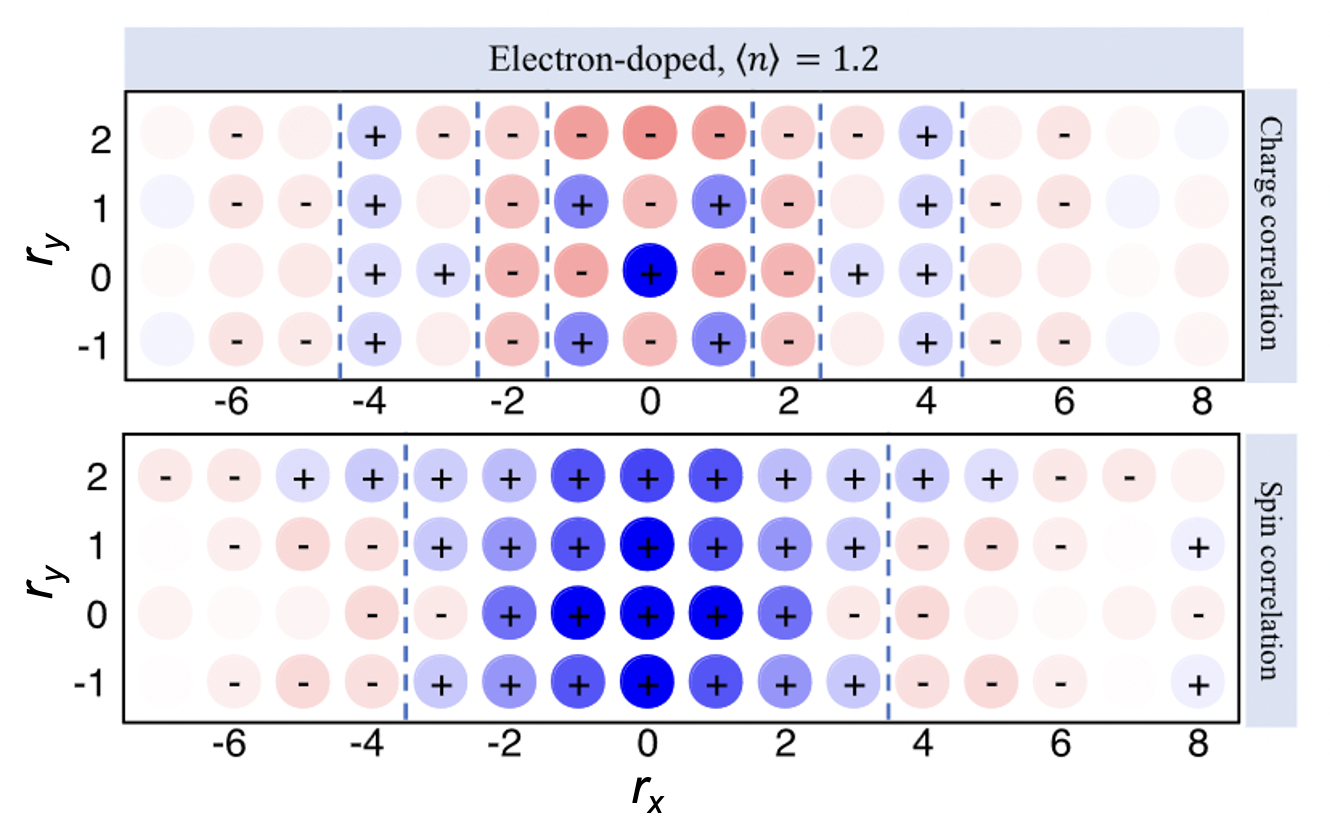 P. Mai
et al., Nature Communications 14, 2889 (2023) —
Intertwined unidirectional spin- and charge modulations (e.g., stripes) are
ubiquitous features of both the high-temperature superconducting cuprates.
Here, we studied the spin and charge correlations of the electron-doped
two-dimensional Hubbard model and contrasted them with the hole-doped case
using the dynamical cluster approximation with a quantum Monte Carlo cluster
solver. We found evidence for robust two-component charge correlations on the
electron-doped side, consisting of superimposed checkerboard and
stripe-like components. These charge correlations are further decoupled
from any stripe-like modulations of the spins and instead coexist with
short-range antiferromagnetic correlations, in contrast to the hole-doped
case. Our results also agree well with observed the doping dependence of charge
modulations.
P. Mai
et al., Nature Communications 14, 2889 (2023) —
Intertwined unidirectional spin- and charge modulations (e.g., stripes) are
ubiquitous features of both the high-temperature superconducting cuprates.
Here, we studied the spin and charge correlations of the electron-doped
two-dimensional Hubbard model and contrasted them with the hole-doped case
using the dynamical cluster approximation with a quantum Monte Carlo cluster
solver. We found evidence for robust two-component charge correlations on the
electron-doped side, consisting of superimposed checkerboard and
stripe-like components. These charge correlations are further decoupled
from any stripe-like modulations of the spins and instead coexist with
short-range antiferromagnetic correlations, in contrast to the hole-doped
case. Our results also agree well with observed the doping dependence of charge
modulations.
Evidence for chiral d-wave superconductivity in a third of a monolayer of Tin
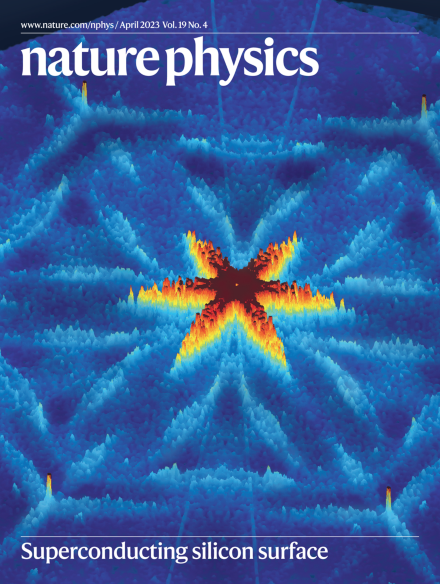 F. Ming
et al., Nature Physics 19, 500 (2023) —
Tin adatoms on a Si(111) substrate with a one-third monolayer coverage
form a two-dimensional triangular lattice with one unpaired electron per
site. These electrons order into an antiferromagnetic
Mott-insulating
state, but doping the Sn layer with holes creates a two-dimensional
conductor that becomes
superconducting
at low temperatures. Although the
pairing symmetry of the superconducting state is currently unknown, the
combination of repulsive interactions and frustration inherent in the
triangular adatom lattice opens up the possibility of a chiral order
parameter. Collaborating with
Prof.
Weitering's group,
we studied the superconducting state of Sn/Si(111) using
scanning tunnelling microscopy, scanning tunnelling spectroscopy and
quasiparticle interference imaging. We found evidence for
a doping-dependent superconducting critical temperature with a fully
gapped order parameter, the presence of time-reversal symmetry breaking,
and a strong enhancement in zero-bias conductance near the edges of the
superconducting domains. Our combined results suggest the
superconduting state in Sn/Si(111) has an unconventional chiral d-wave
superconductor.
F. Ming
et al., Nature Physics 19, 500 (2023) —
Tin adatoms on a Si(111) substrate with a one-third monolayer coverage
form a two-dimensional triangular lattice with one unpaired electron per
site. These electrons order into an antiferromagnetic
Mott-insulating
state, but doping the Sn layer with holes creates a two-dimensional
conductor that becomes
superconducting
at low temperatures. Although the
pairing symmetry of the superconducting state is currently unknown, the
combination of repulsive interactions and frustration inherent in the
triangular adatom lattice opens up the possibility of a chiral order
parameter. Collaborating with
Prof.
Weitering's group,
we studied the superconducting state of Sn/Si(111) using
scanning tunnelling microscopy, scanning tunnelling spectroscopy and
quasiparticle interference imaging. We found evidence for
a doping-dependent superconducting critical temperature with a fully
gapped order parameter, the presence of time-reversal symmetry breaking,
and a strong enhancement in zero-bias conductance near the edges of the
superconducting domains. Our combined results suggest the
superconduting state in Sn/Si(111) has an unconventional chiral d-wave
superconductor.
Hybrid Monte Carlo study of charge order in BaBiO3
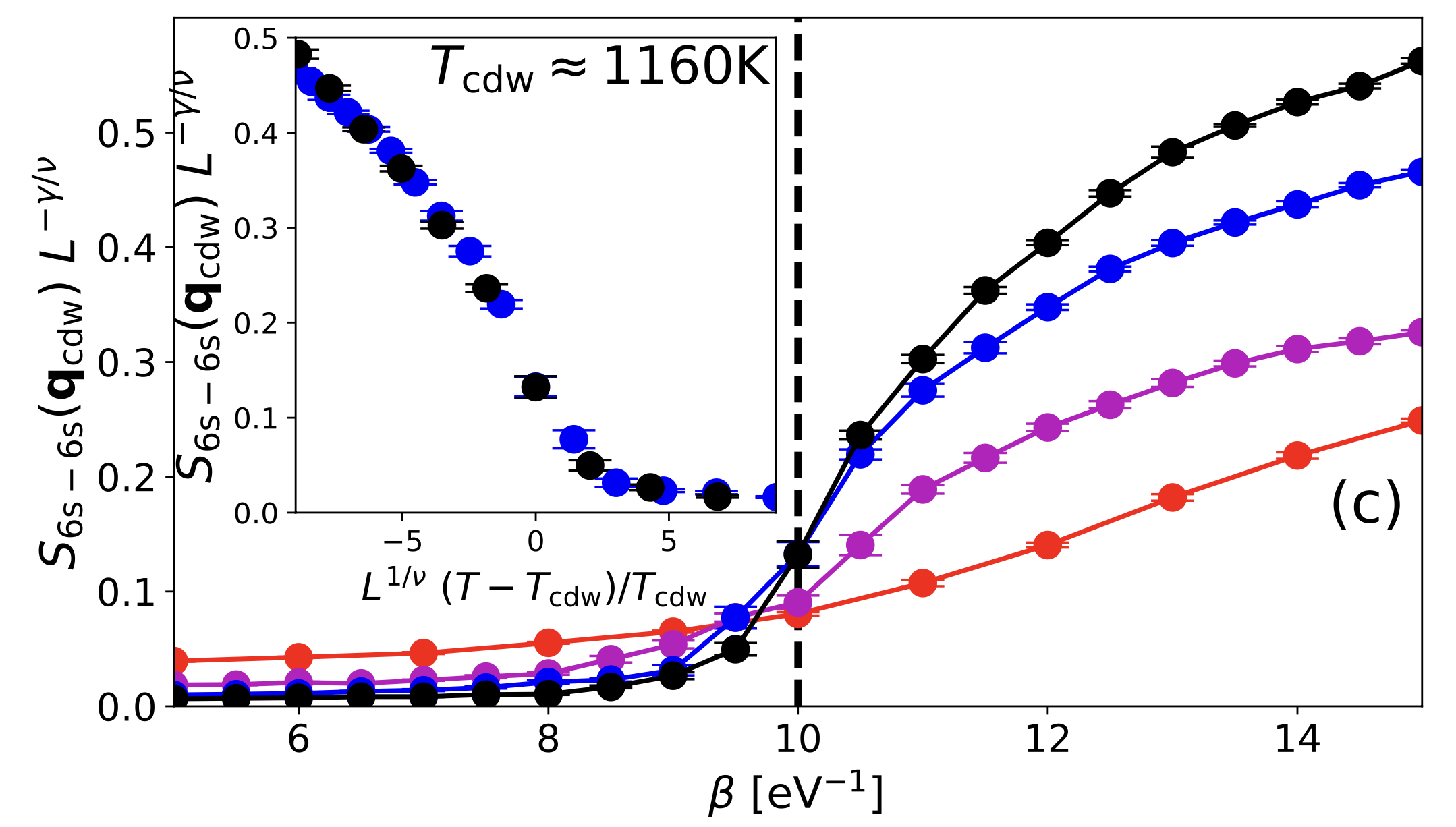 B. Cohen-Stead
et al., npj Computational Materials 9, 40 (2023) —
The barium family of superconductors
Ba1-xKxBiO3 (BKBO) and
Ba1-xBixPbO3 exhibit high-temperature
superconductivity in proximity to a charge-density-wave (CDW) insulating
phase, with a reported critical temperature of Tc = 32 K at
x = 0.35 in BKBO. The underlying pairing mechanism in the superconducting
phase, and its proximity to a charge ordered phase, remains unsettled.
However, experimental results indicate the electron-phonon (e-ph)
interactions may play an important role in explaing the low-energy physics.
Here we study the CDW transition in BaBiO3, the parent compound
of the bismuthate superconductors. We simulate an effective
electron-phonon model using a recently introduced hybrid quantum Monte
Carlo method. Our multi-orbital model includes the Bi 6s and O 2p
orbitals and a coupling to the Bi-O bond-stretching branch of optical
phonons via the Su-Schrieffer–Heeger (SSH)-like modulation of the Bi-O
hopping integral. Our results demonstrate that an SSH coupling mechanism
to the bond-stretching optical oxygen modes accounts for all aspects of
the CDW phase in this compound. Our work provides for a similar
computationally rigorous solution of a model appropriate to the CDW phase
of the bismuthates and may provide valuable insight into the origin of
the superconducting phase in the barium family of superconductors.
B. Cohen-Stead
et al., npj Computational Materials 9, 40 (2023) —
The barium family of superconductors
Ba1-xKxBiO3 (BKBO) and
Ba1-xBixPbO3 exhibit high-temperature
superconductivity in proximity to a charge-density-wave (CDW) insulating
phase, with a reported critical temperature of Tc = 32 K at
x = 0.35 in BKBO. The underlying pairing mechanism in the superconducting
phase, and its proximity to a charge ordered phase, remains unsettled.
However, experimental results indicate the electron-phonon (e-ph)
interactions may play an important role in explaing the low-energy physics.
Here we study the CDW transition in BaBiO3, the parent compound
of the bismuthate superconductors. We simulate an effective
electron-phonon model using a recently introduced hybrid quantum Monte
Carlo method. Our multi-orbital model includes the Bi 6s and O 2p
orbitals and a coupling to the Bi-O bond-stretching branch of optical
phonons via the Su-Schrieffer–Heeger (SSH)-like modulation of the Bi-O
hopping integral. Our results demonstrate that an SSH coupling mechanism
to the bond-stretching optical oxygen modes accounts for all aspects of
the CDW phase in this compound. Our work provides for a similar
computationally rigorous solution of a model appropriate to the CDW phase
of the bismuthates and may provide valuable insight into the origin of
the superconducting phase in the barium family of superconductors.
Robust charge-density-wave correlations in the electron-doped single-band Hubbard model
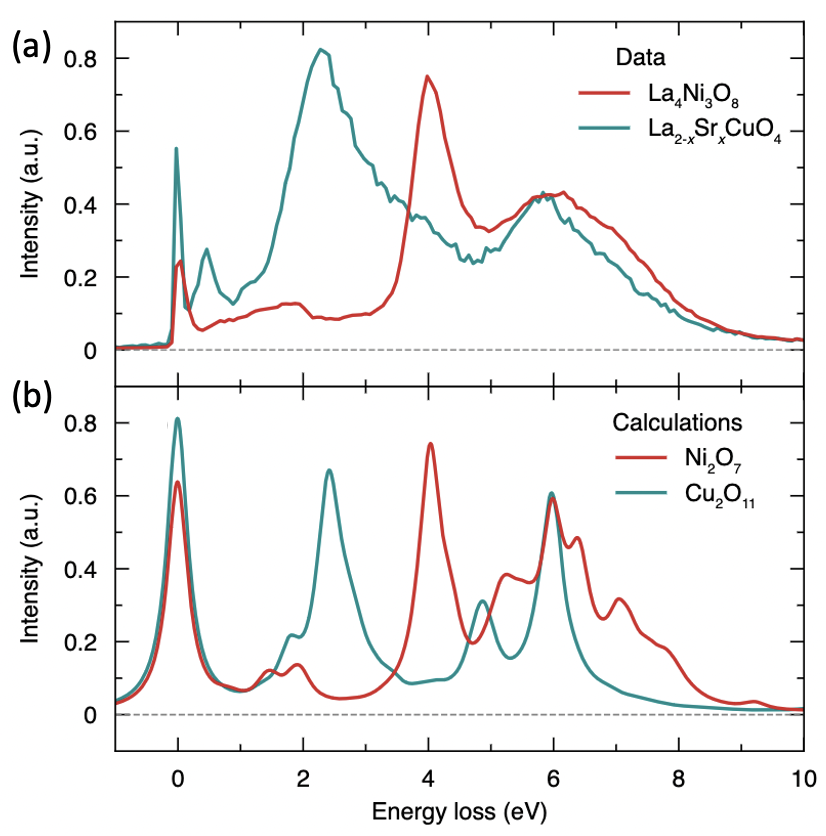 Y. Shen
et al., Phys. Rev. X 12, 011055 (2022);
Y. Shen et al., Phys. Rev. X 13, 011021 (2023)
We have recently identified
a minimal model for the recently discovered low-valence superconducting nickelates.
The Ni atoms in these materials have a smaller
nuclear charge than Cu in cuprates, which would tend to increase the
charge transfer energy. This expectation motivated extensive
interest in determining the Mott-Hubbard versus charge-transfer nature
of square-planar nickelates, with some researchers categorizing
them as Mott-Hubbard systems, and others regarding them as cuprate
analogs. We answered this question in a set of combined experimental and
theoretical studies. First, we performed O K-edge RIXS
measurements of La4Ni3O8 alongside a cuprate
La2−xSrxCuO4 with
equivalent effective doping (x = 1/3). The results established that
low-valence nickelates are of mixed charge-transfer/Mott-Hubbard
character with Coulomb repulsion being compatible to the charge-transfer
energy. This endows these materials with partly (but not
completely) cuprate-like properties and explains the moderate magnetic
superexchange observed previously in these materials.
Charge order is a ubiquitous feature in both the cuprate and
nickelates, but the electronic character of this symmetry
breaking is controversial. Therefore, we also studied
La4Ni3O8’s charge ordered phase using
Ni L2-edge RIXS measurements and
calculations. This work extended our model by introducing charge order
via the application of a site-dependent potential difference and
identified intertwined involvements of Ni 3d, 3d, and
O 2p orbitals in the charge order.
The Ni 3d x2−y2 orbitals, strongly hybridized with
planar O 2p orbitals, largely shape the spatial charge
distribution and lead to a Ni site-centered charge order.
Y. Shen
et al., Phys. Rev. X 12, 011055 (2022);
Y. Shen et al., Phys. Rev. X 13, 011021 (2023)
We have recently identified
a minimal model for the recently discovered low-valence superconducting nickelates.
The Ni atoms in these materials have a smaller
nuclear charge than Cu in cuprates, which would tend to increase the
charge transfer energy. This expectation motivated extensive
interest in determining the Mott-Hubbard versus charge-transfer nature
of square-planar nickelates, with some researchers categorizing
them as Mott-Hubbard systems, and others regarding them as cuprate
analogs. We answered this question in a set of combined experimental and
theoretical studies. First, we performed O K-edge RIXS
measurements of La4Ni3O8 alongside a cuprate
La2−xSrxCuO4 with
equivalent effective doping (x = 1/3). The results established that
low-valence nickelates are of mixed charge-transfer/Mott-Hubbard
character with Coulomb repulsion being compatible to the charge-transfer
energy. This endows these materials with partly (but not
completely) cuprate-like properties and explains the moderate magnetic
superexchange observed previously in these materials.
Charge order is a ubiquitous feature in both the cuprate and
nickelates, but the electronic character of this symmetry
breaking is controversial. Therefore, we also studied
La4Ni3O8’s charge ordered phase using
Ni L2-edge RIXS measurements and
calculations. This work extended our model by introducing charge order
via the application of a site-dependent potential difference and
identified intertwined involvements of Ni 3d, 3d, and
O 2p orbitals in the charge order.
The Ni 3d x2−y2 orbitals, strongly hybridized with
planar O 2p orbitals, largely shape the spatial charge
distribution and lead to a Ni site-centered charge order.
Stripe correlations in the Hubbard-Holstein model
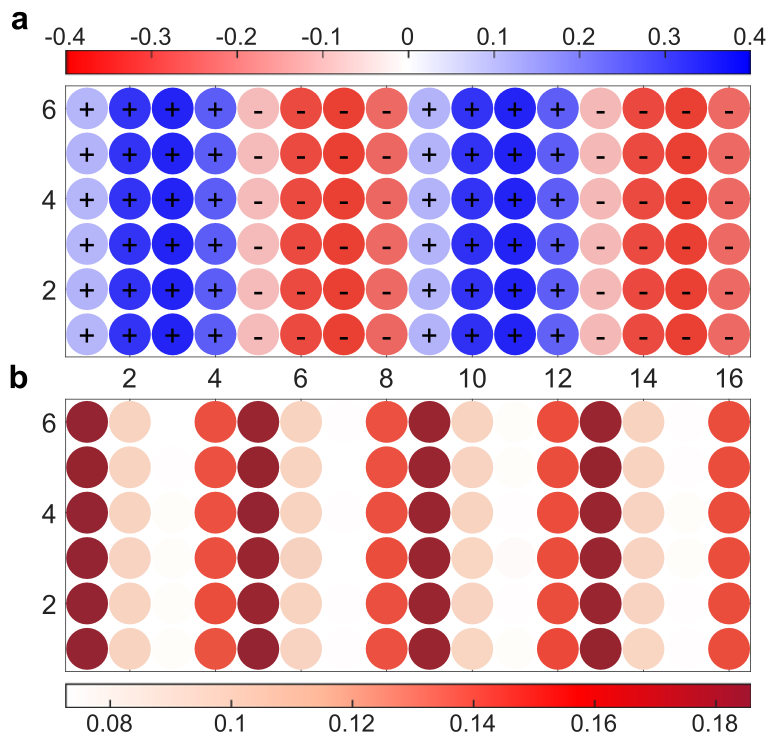 S. Karakuzu et al., Communications Physics 5, 311 (2022) —
Over the last decade, several state-of-the-art numerical methods have observed static or fluctuating spin and charge
stripes in doped two-dimensional Hubbard models, suggesting that these orders play a significant role in shaping the
cuprate phase diagram. Many experiments, however, also indicate that the cuprates have strong electron-phonon (e-ph)
coupling, but it is unclear how this interaction influences stripe correlations. We study static and fluctuating stripe
orders in the doped single-band Hubbard-Holstein model using zero temperature variational Monte Carlo and finite
temperature determinant quantum Monte Carlo. We find that the lattice couples more strongly with the charge component
of the stripes, leading to an enhancement or suppression of stripe
correlations, depending on model parameters.
S. Karakuzu et al., Communications Physics 5, 311 (2022) —
Over the last decade, several state-of-the-art numerical methods have observed static or fluctuating spin and charge
stripes in doped two-dimensional Hubbard models, suggesting that these orders play a significant role in shaping the
cuprate phase diagram. Many experiments, however, also indicate that the cuprates have strong electron-phonon (e-ph)
coupling, but it is unclear how this interaction influences stripe correlations. We study static and fluctuating stripe
orders in the doped single-band Hubbard-Holstein model using zero temperature variational Monte Carlo and finite
temperature determinant quantum Monte Carlo. We find that the lattice couples more strongly with the charge component
of the stripes, leading to an enhancement or suppression of stripe
correlations, depending on model parameters.
The dynamical properties of doped corner-shared Cuprate spin chains
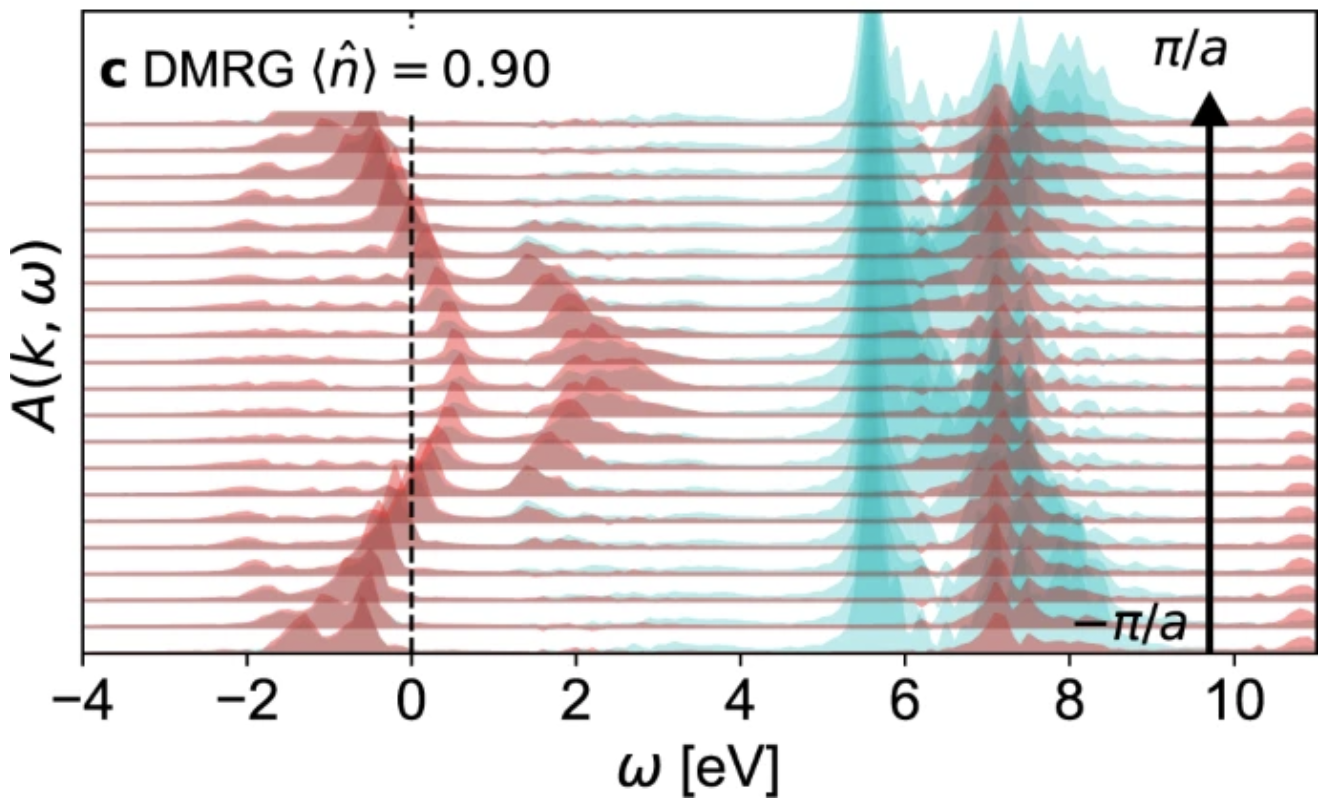 S. Li et al., Communications Physics 4, 217 (2021) —
Although many experiments imply that oxygen orbitals play an essential role
in the high-temperature superconducting cuprates, their precise role in
collective spin and charge excitations and superconductivity is not yet
fully understood. Here, we study the doping-dependent dynamical spin and
charge structure factors of single and multi-orbital (pd) models for doped
one-dimensional corner-shared spin-chain cuprates using determinant quantum
Monte Carlo, Density Matrix Renormalization group, and exact
diagonalization. In doing so, we provided detailed predictions for the
electronic structure and dynamical spin and charge correlation functions
of doped cuprate spin chains. We observe a particle-hole asymmetry in the
orbital-resolved charge excitations, which is directly relevant to resonant
inelastic x-ray scattering experiments and not captured by the single-band
Hubbard model.
S. Li et al., Communications Physics 4, 217 (2021) —
Although many experiments imply that oxygen orbitals play an essential role
in the high-temperature superconducting cuprates, their precise role in
collective spin and charge excitations and superconductivity is not yet
fully understood. Here, we study the doping-dependent dynamical spin and
charge structure factors of single and multi-orbital (pd) models for doped
one-dimensional corner-shared spin-chain cuprates using determinant quantum
Monte Carlo, Density Matrix Renormalization group, and exact
diagonalization. In doing so, we provided detailed predictions for the
electronic structure and dynamical spin and charge correlation functions
of doped cuprate spin chains. We observe a particle-hole asymmetry in the
orbital-resolved charge excitations, which is directly relevant to resonant
inelastic x-ray scattering experiments and not captured by the single-band
Hubbard model.
The structure of a Cooper pair in the cuprates
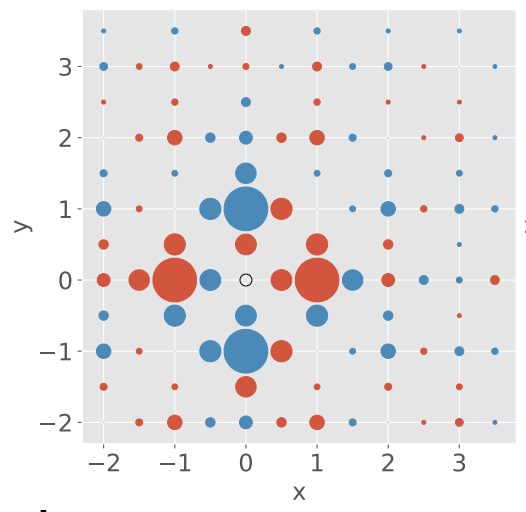 P. Mai et al., npj Quantum Materials 6, 26 (2021) —
We performed the state-of-the-art dynamic cluster approximation (DCA) quantum Monte Carlo (QMC) calculations of the three-band Hubbard model. We then determined the structure of the Cooper pairs and thus obtained a non-perturbative picture of the pairing interaction from solving the Bethe-Salpeter equation. We find that the interaction predominately acts between neighboring copper orbitals, but with significant additional weight appearing on the surrounding bonding molecular oxygen orbitals. This rich orbital structure simplifies once we frame it in terms of the molecular orbitals of the Zhang-Rice Singlet (ZRS), and then is well compared with that from an effective single-band Hubbard model. Our results strongly support that, even when the oxygen orbitals contribute significantly to the low-energy electronic degrees of freedom, a single-band Hubbard model provides an adequate frame-work to understand the pairing in the cuprates.
P. Mai et al., npj Quantum Materials 6, 26 (2021) —
We performed the state-of-the-art dynamic cluster approximation (DCA) quantum Monte Carlo (QMC) calculations of the three-band Hubbard model. We then determined the structure of the Cooper pairs and thus obtained a non-perturbative picture of the pairing interaction from solving the Bethe-Salpeter equation. We find that the interaction predominately acts between neighboring copper orbitals, but with significant additional weight appearing on the surrounding bonding molecular oxygen orbitals. This rich orbital structure simplifies once we frame it in terms of the molecular orbitals of the Zhang-Rice Singlet (ZRS), and then is well compared with that from an effective single-band Hubbard model. Our results strongly support that, even when the oxygen orbitals contribute significantly to the low-energy electronic degrees of freedom, a single-band Hubbard model provides an adequate frame-work to understand the pairing in the cuprates.
Dynamical Mean-field theory on a quantum computer
 T. Keen et al., Quantum Science and Technology 5, 035001 (2020) —
We implemented a quantum-classical scheme for two-site dynamical mean-field theory (DMFT) applied to the single-band Hubbard model. These types of quantum-classical approaches can circumvent the exponential scaling inherent to classical algorithms, e.g. in storage requirements or computation time. The quantum part of the algorithm (i.e. the calculation of the impurity Green’s function in the time domain) was solved on one of IBM’s superconducting qubit chips. As a test case, we considered the Hubbard model. We found that the Trotter error introduced by approximating the time evolution operator produces unreliable updates in the impurity-bath hybridization parameter when calculated using methods proposed in the literature. This inaccuracy resulted in erroneous convergence in the DMFT loop, an issue that was compounded by noise in the quantum device. These results prompted us to employ a different method for updating the hybridization parameters, which allowed us to obtain convergence in the Mott insulating regime.
T. Keen et al., Quantum Science and Technology 5, 035001 (2020) —
We implemented a quantum-classical scheme for two-site dynamical mean-field theory (DMFT) applied to the single-band Hubbard model. These types of quantum-classical approaches can circumvent the exponential scaling inherent to classical algorithms, e.g. in storage requirements or computation time. The quantum part of the algorithm (i.e. the calculation of the impurity Green’s function in the time domain) was solved on one of IBM’s superconducting qubit chips. As a test case, we considered the Hubbard model. We found that the Trotter error introduced by approximating the time evolution operator produces unreliable updates in the impurity-bath hybridization parameter when calculated using methods proposed in the literature. This inaccuracy resulted in erroneous convergence in the DMFT loop, an issue that was compounded by noise in the quantum device. These results prompted us to employ a different method for updating the hybridization parameters, which allowed us to obtain convergence in the Mott insulating regime.
Accelerating lattice quantum Monte Carlo simulations using artificial neural networks
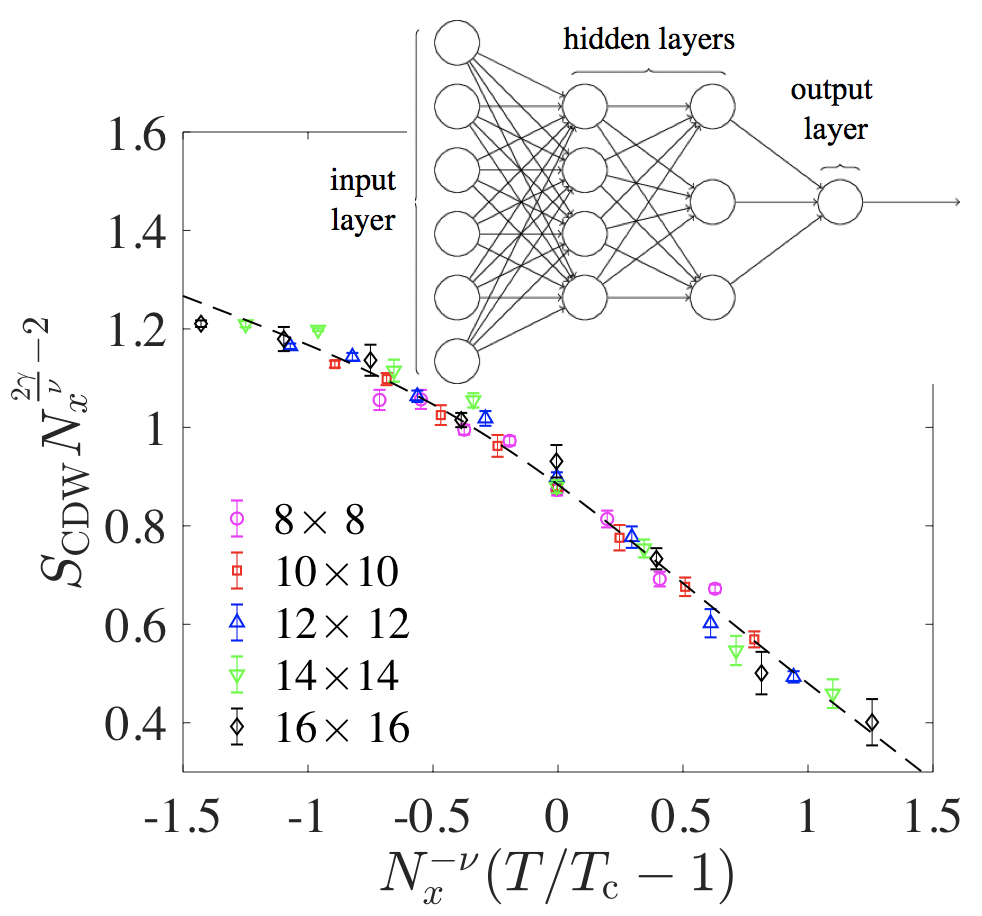 S. Li et al., Phys. Rev. B 100, 020302(R) (2019) —
We designed artificial neural networks (ANNs) that predict with near-perfect accuracy state change probabilities in quantum Monte Carlo (QMC) simulations of many-body Hamiltonians and obtain an order of magnitude reduction in run time. This demonstration that machines can learn to perform efficient QMC simulations— without being provided with an underlying physics model and given only limited information about the configuration space—means the method can be easily generalized even to other challenging models, such as the Fermi-Hubbard model. The utility of this approach was demonstrated by integrating it into QMC simulations of the two-dimensional Holstein model describing interactions between electrons and lattice vibrations in materials. After training ANNs with data generated on small, inexpensive systems, researchers applied these ANNs to larger systems and achieved an order of magnitude speed-up in the QMC simulation. This capability allowed researchers using the model to access the Ising critical behavior of the metal-to-charge density wave (CDW) insulator transition, elucidating the universality class of this important phase transition.
S. Li et al., Phys. Rev. B 100, 020302(R) (2019) —
We designed artificial neural networks (ANNs) that predict with near-perfect accuracy state change probabilities in quantum Monte Carlo (QMC) simulations of many-body Hamiltonians and obtain an order of magnitude reduction in run time. This demonstration that machines can learn to perform efficient QMC simulations— without being provided with an underlying physics model and given only limited information about the configuration space—means the method can be easily generalized even to other challenging models, such as the Fermi-Hubbard model. The utility of this approach was demonstrated by integrating it into QMC simulations of the two-dimensional Holstein model describing interactions between electrons and lattice vibrations in materials. After training ANNs with data generated on small, inexpensive systems, researchers applied these ANNs to larger systems and achieved an order of magnitude speed-up in the QMC simulation. This capability allowed researchers using the model to access the Ising critical behavior of the metal-to-charge density wave (CDW) insulator transition, elucidating the universality class of this important phase transition.
Phase Diagram of the Holstein Model
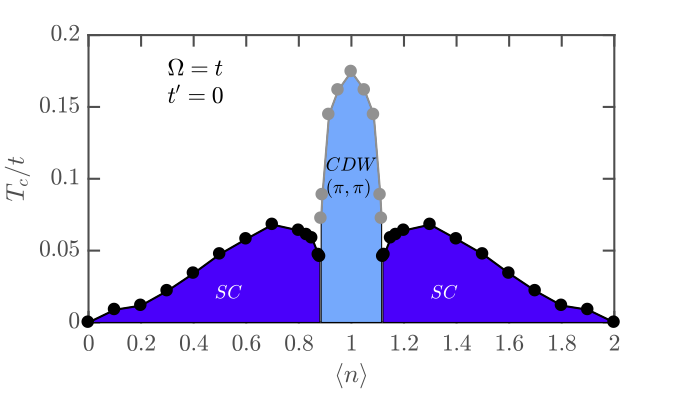 P. M. Dee et al., Phys. Rev. B 99, 024514 (2019) —
The Holstein model has long been used to study
superconductivity, charge-density waves (CDW), and polarons. Much is known
about the possible phases this model yields, yet there are very few studies
reporting the full temperature-doping phase diagram. Within the
weak coupling regime, we studied the temperature-filling phase diagram of the
two-dimensional single-band Holstein model under the self-consistent Migdal
approximation using our
state-of-the-art numerical algorithm. Among our many
findings is a superconducting Tc-dome away from half-filling. We show that
this non-monotonicity stems from several competing factors related to the
quasiparticle renormalization.
P. M. Dee et al., Phys. Rev. B 99, 024514 (2019) —
The Holstein model has long been used to study
superconductivity, charge-density waves (CDW), and polarons. Much is known
about the possible phases this model yields, yet there are very few studies
reporting the full temperature-doping phase diagram. Within the
weak coupling regime, we studied the temperature-filling phase diagram of the
two-dimensional single-band Holstein model under the self-consistent Migdal
approximation using our
state-of-the-art numerical algorithm. Among our many
findings is a superconducting Tc-dome away from half-filling. We show that
this non-monotonicity stems from several competing factors related to the
quasiparticle renormalization.
Probing multi-spinon excitations with RIXS
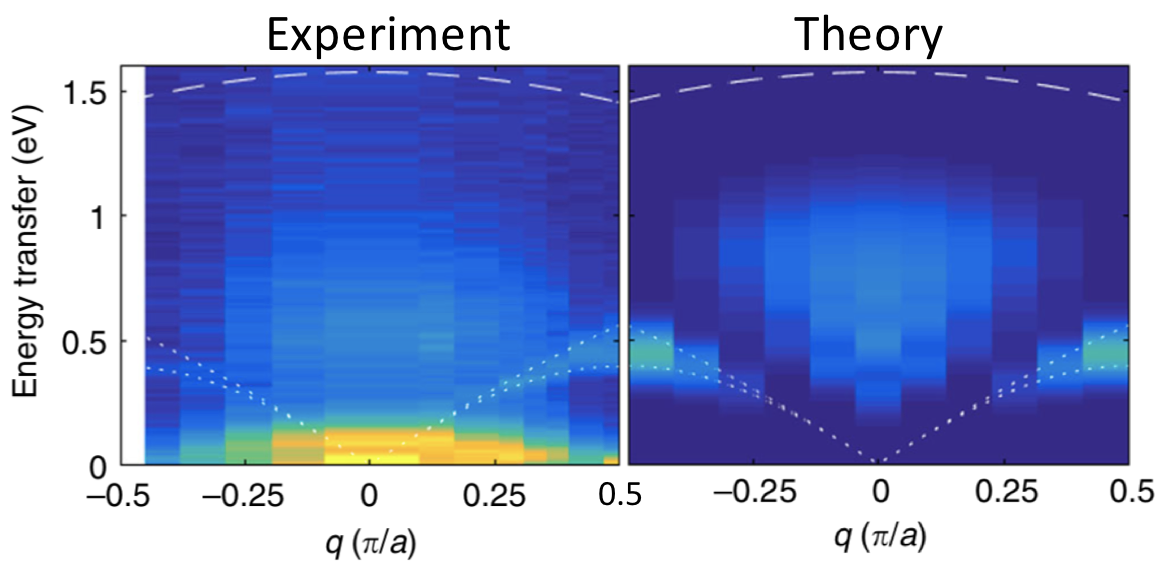 J. Schlappa et al., Nat. Commun. 9, 5394 (2018) —
One-dimensional (1D) spin-1/2 magnetic insulators realize novel
emergent quantum phenomena like quasiparticle fractionalization and quantum criticality.
Their elementary magnetic excitations are
spin-1/2 quasiparticles called spinons that typically are created in even numbers. While
the continuum associated with two-spinon excitations is routinely
observed, the study of higher multi-spinon states is ongoing.
This study showed that four-spinon excitations can be accessed directly in a
region of phase space clearly separated from the two-spinon continuum in
Sr2CuO3 using RIXS. This observation is made possible by the nature of the
correlation function probed by RIXS, and holds promise as a tool in the
search for novel quantum states and quantum spin liquids.
J. Schlappa et al., Nat. Commun. 9, 5394 (2018) —
One-dimensional (1D) spin-1/2 magnetic insulators realize novel
emergent quantum phenomena like quasiparticle fractionalization and quantum criticality.
Their elementary magnetic excitations are
spin-1/2 quasiparticles called spinons that typically are created in even numbers. While
the continuum associated with two-spinon excitations is routinely
observed, the study of higher multi-spinon states is ongoing.
This study showed that four-spinon excitations can be accessed directly in a
region of phase space clearly separated from the two-spinon continuum in
Sr2CuO3 using RIXS. This observation is made possible by the nature of the
correlation function probed by RIXS, and holds promise as a tool in the
search for novel quantum states and quantum spin liquids.
Computing RIXS spectra using DMRG
A. Nocera et al., Sci. Rep. 8, 11080 (2018) —
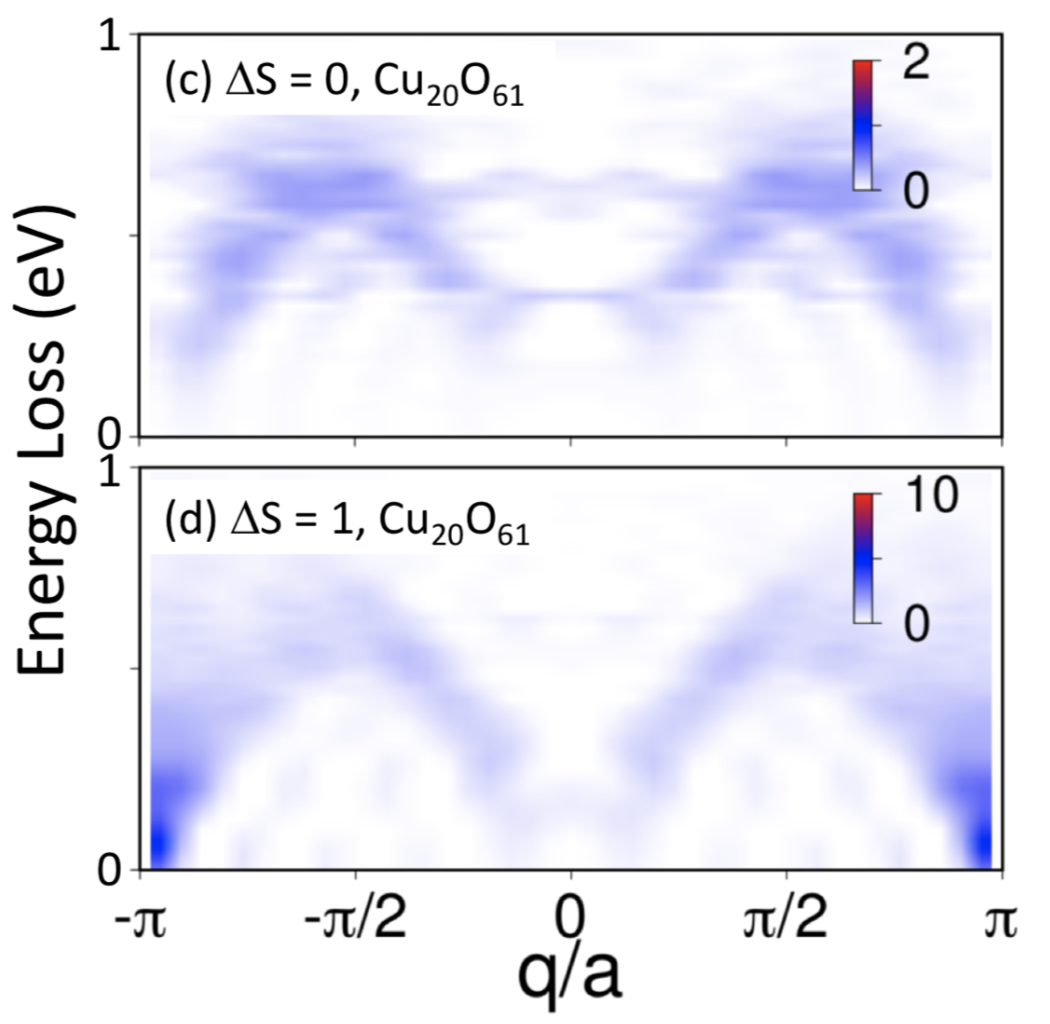 We developed an algorithm for computing RIXS spectra
with the density matrix renormalization group (DMRG) method.
The new approach shifts the computational bottleneck from memory to the
CPU and makes it possible to model large quasi-1D clusters
well beyond those treated to date using exact diagionalization. For example, the
figure shows the magnetic RIXS response of the 1D AFM Sr2CuO3 obtained
from large multi-orbital Cu20O61 chains, which grants access to
the full momentum structure of the collective magnetic excitations in this multiorbital system.
We developed an algorithm for computing RIXS spectra
with the density matrix renormalization group (DMRG) method.
The new approach shifts the computational bottleneck from memory to the
CPU and makes it possible to model large quasi-1D clusters
well beyond those treated to date using exact diagionalization. For example, the
figure shows the magnetic RIXS response of the 1D AFM Sr2CuO3 obtained
from large multi-orbital Cu20O61 chains, which grants access to
the full momentum structure of the collective magnetic excitations in this multiorbital system.
 We developed an algorithm for computing RIXS spectra
with the density matrix renormalization group (DMRG) method.
The new approach shifts the computational bottleneck from memory to the
CPU and makes it possible to model large quasi-1D clusters
well beyond those treated to date using exact diagionalization. For example, the
figure shows the magnetic RIXS response of the 1D AFM Sr2CuO3 obtained
from large multi-orbital Cu20O61 chains, which grants access to
the full momentum structure of the collective magnetic excitations in this multiorbital system.
We developed an algorithm for computing RIXS spectra
with the density matrix renormalization group (DMRG) method.
The new approach shifts the computational bottleneck from memory to the
CPU and makes it possible to model large quasi-1D clusters
well beyond those treated to date using exact diagionalization. For example, the
figure shows the magnetic RIXS response of the 1D AFM Sr2CuO3 obtained
from large multi-orbital Cu20O61 chains, which grants access to
the full momentum structure of the collective magnetic excitations in this multiorbital system.
Electron-lattice interactions in FeSe/STO interfaces
J. J. Lee et al. Nature 515, 245 (2014) —
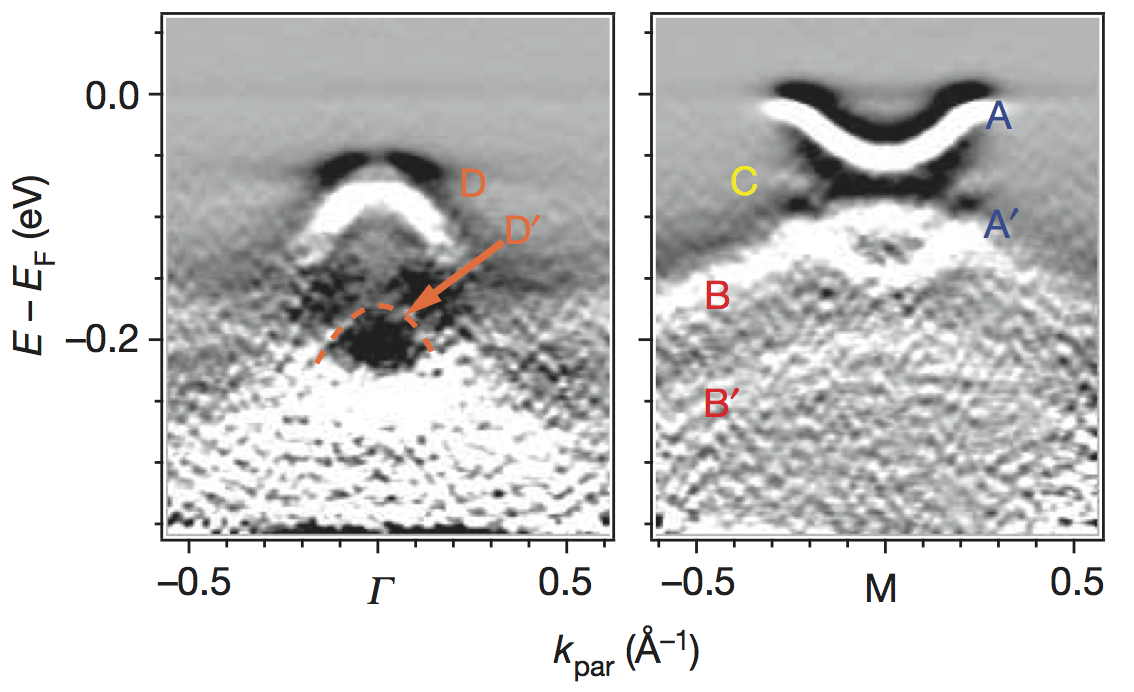 The discovery of
enhanced superconductivity in ultrathin films of FeSe grown on oxide substrates
like SrTiO3 has generated intense research efforts into the
mechanism behind this novel phenomenon. In collaboration with Prof. Shen's group at
Stanford University, we reported angle-resolved
photoemission spectroscopy results that reveal the presense of replica bands in the
electronic structure of single-unit-cell FeSe/STO system. These features suggest the
presence of coupling between oxygen surface phonons in STO and the FeSe
electrons that is peaked at small momentum transfers. Such coupling assists
superconductivity in most channels, which suggest that this interaction is
responsible for raising the superconducting Tc of this system.
In a more recent collaboration,
[S. Zhang et al.,
PRB 97, 035408 (2018)] we examined the linewidths of the
FeSe and STO phonon modes to reveal an anomalous broadening of the STO-derived modes.
The discovery of
enhanced superconductivity in ultrathin films of FeSe grown on oxide substrates
like SrTiO3 has generated intense research efforts into the
mechanism behind this novel phenomenon. In collaboration with Prof. Shen's group at
Stanford University, we reported angle-resolved
photoemission spectroscopy results that reveal the presense of replica bands in the
electronic structure of single-unit-cell FeSe/STO system. These features suggest the
presence of coupling between oxygen surface phonons in STO and the FeSe
electrons that is peaked at small momentum transfers. Such coupling assists
superconductivity in most channels, which suggest that this interaction is
responsible for raising the superconducting Tc of this system.
In a more recent collaboration,
[S. Zhang et al.,
PRB 97, 035408 (2018)] we examined the linewidths of the
FeSe and STO phonon modes to reveal an anomalous broadening of the STO-derived modes.
 The discovery of
enhanced superconductivity in ultrathin films of FeSe grown on oxide substrates
like SrTiO3 has generated intense research efforts into the
mechanism behind this novel phenomenon. In collaboration with Prof. Shen's group at
Stanford University, we reported angle-resolved
photoemission spectroscopy results that reveal the presense of replica bands in the
electronic structure of single-unit-cell FeSe/STO system. These features suggest the
presence of coupling between oxygen surface phonons in STO and the FeSe
electrons that is peaked at small momentum transfers. Such coupling assists
superconductivity in most channels, which suggest that this interaction is
responsible for raising the superconducting Tc of this system.
In a more recent collaboration,
[S. Zhang et al.,
PRB 97, 035408 (2018)] we examined the linewidths of the
FeSe and STO phonon modes to reveal an anomalous broadening of the STO-derived modes.
The discovery of
enhanced superconductivity in ultrathin films of FeSe grown on oxide substrates
like SrTiO3 has generated intense research efforts into the
mechanism behind this novel phenomenon. In collaboration with Prof. Shen's group at
Stanford University, we reported angle-resolved
photoemission spectroscopy results that reveal the presense of replica bands in the
electronic structure of single-unit-cell FeSe/STO system. These features suggest the
presence of coupling between oxygen surface phonons in STO and the FeSe
electrons that is peaked at small momentum transfers. Such coupling assists
superconductivity in most channels, which suggest that this interaction is
responsible for raising the superconducting Tc of this system.
In a more recent collaboration,
[S. Zhang et al.,
PRB 97, 035408 (2018)] we examined the linewidths of the
FeSe and STO phonon modes to reveal an anomalous broadening of the STO-derived modes.
Theory of forward scattering in FeSe/STO interfaces
L. Rademaker et al., NJP 20, 022001 (2016) —
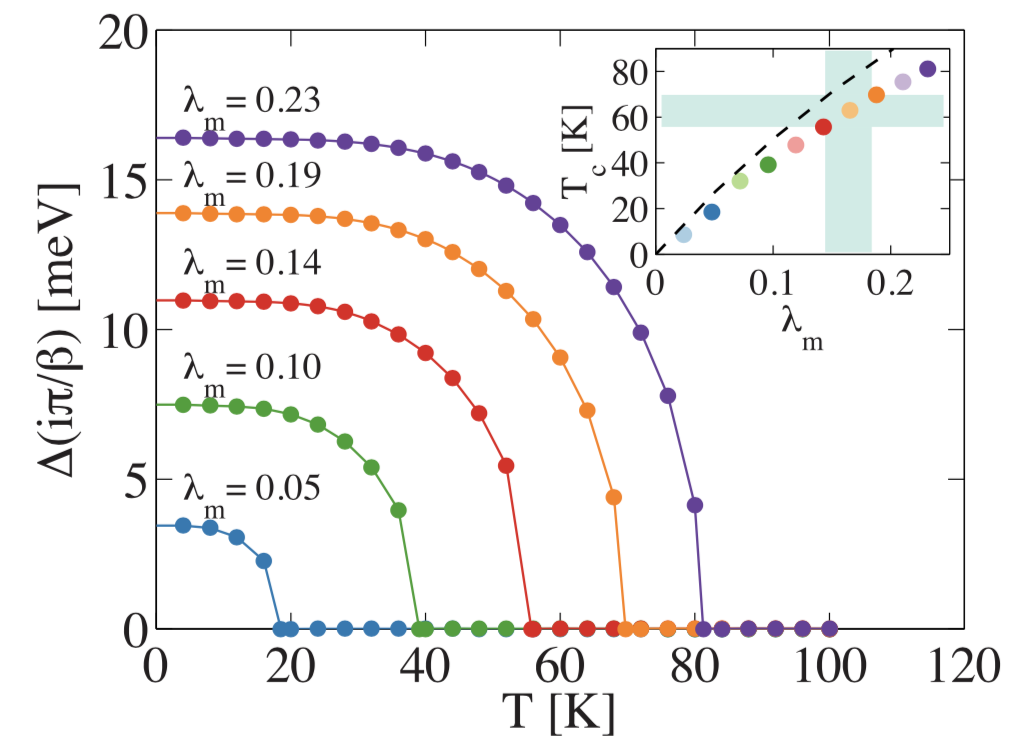 Motivated by the observation of
replica bands in the FeSe/STO monolayers, we have developed the theory of forward-focused
electron-phonon interactions within a fully momentum-resolved Eliashberg framework. We argue
that this model accounts for many of the observed properties of this novel system,
including the formation of replica bands and the observed enhanced superconducting Tc values.
We have also explored many of the consequences of this model in a series of related follow-up studies:
A. Kumar et al.,
EPL 124, 67002 (2018);
Y. Wang et al., PRB 96, 054515 (2017);
Y. Wang et al., PRB 96, 134513 (2017); and
Y. Wang et al., SUST 29, 054009 (2016).
Motivated by the observation of
replica bands in the FeSe/STO monolayers, we have developed the theory of forward-focused
electron-phonon interactions within a fully momentum-resolved Eliashberg framework. We argue
that this model accounts for many of the observed properties of this novel system,
including the formation of replica bands and the observed enhanced superconducting Tc values.
We have also explored many of the consequences of this model in a series of related follow-up studies:
A. Kumar et al.,
EPL 124, 67002 (2018);
Y. Wang et al., PRB 96, 054515 (2017);
Y. Wang et al., PRB 96, 134513 (2017); and
Y. Wang et al., SUST 29, 054009 (2016).
 Motivated by the observation of
replica bands in the FeSe/STO monolayers, we have developed the theory of forward-focused
electron-phonon interactions within a fully momentum-resolved Eliashberg framework. We argue
that this model accounts for many of the observed properties of this novel system,
including the formation of replica bands and the observed enhanced superconducting Tc values.
We have also explored many of the consequences of this model in a series of related follow-up studies:
A. Kumar et al.,
EPL 124, 67002 (2018);
Y. Wang et al., PRB 96, 054515 (2017);
Y. Wang et al., PRB 96, 134513 (2017); and
Y. Wang et al., SUST 29, 054009 (2016).
Motivated by the observation of
replica bands in the FeSe/STO monolayers, we have developed the theory of forward-focused
electron-phonon interactions within a fully momentum-resolved Eliashberg framework. We argue
that this model accounts for many of the observed properties of this novel system,
including the formation of replica bands and the observed enhanced superconducting Tc values.
We have also explored many of the consequences of this model in a series of related follow-up studies:
A. Kumar et al.,
EPL 124, 67002 (2018);
Y. Wang et al., PRB 96, 054515 (2017);
Y. Wang et al., PRB 96, 134513 (2017); and
Y. Wang et al., SUST 29, 054009 (2016).
Using RIXS to probe electron-phonon interactions in quantum materials
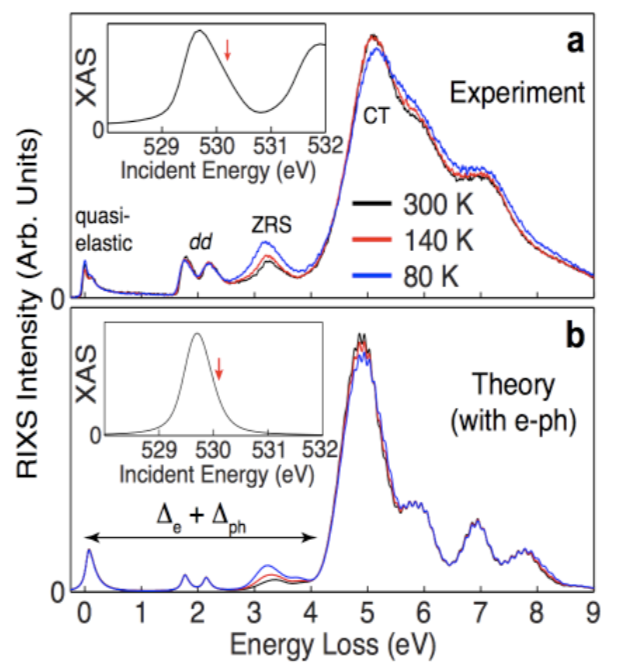 S. Johnston et al., Nat. Commun. 7, 10563 (2016); W. S. Lee et al.,
Phys. Rev. Lett. 110, 265502 (2013)
—
Here, we exploited recent improvements in the resolution of RIXS experiments to examine electron-lattice interactions in
the quasi-1D cuprate Li2CuO2 and Ca2-xY2+xCu5O10. we found that the dynamic
electron-phonon (e-ph) coupling plays a key role in determining the
fundamental electronic and magnetic properties of both of the
materials. These studies highlight the power of RIXS
for accessing and unraveling coupled collective
excitations in quantum materials.
In a recent collaboration [D.
Meyers et al., PRL 121, 236802 (2018)] we extended this approach to
measure e-ph interactions in ultrathin superlattices of
SrIrO3/SrTiO3 (SIO/STO)
Here, we identified a systematic evolution of the intensity of the phonon excitations with varying thicknesses
of the SIO and STO layers. When combined with the observation of a negligible carrier doping into the STO layers, these results
suggest that the e-ph coupling can be decoupled from doping.
These results not only showcases RIXS's potential for probing interactions at buried interfaces, but also indicate a new method
for engineering these interactions in superlattices.
S. Johnston et al., Nat. Commun. 7, 10563 (2016); W. S. Lee et al.,
Phys. Rev. Lett. 110, 265502 (2013)
—
Here, we exploited recent improvements in the resolution of RIXS experiments to examine electron-lattice interactions in
the quasi-1D cuprate Li2CuO2 and Ca2-xY2+xCu5O10. we found that the dynamic
electron-phonon (e-ph) coupling plays a key role in determining the
fundamental electronic and magnetic properties of both of the
materials. These studies highlight the power of RIXS
for accessing and unraveling coupled collective
excitations in quantum materials.
In a recent collaboration [D.
Meyers et al., PRL 121, 236802 (2018)] we extended this approach to
measure e-ph interactions in ultrathin superlattices of
SrIrO3/SrTiO3 (SIO/STO)
Here, we identified a systematic evolution of the intensity of the phonon excitations with varying thicknesses
of the SIO and STO layers. When combined with the observation of a negligible carrier doping into the STO layers, these results
suggest that the e-ph coupling can be decoupled from doping.
These results not only showcases RIXS's potential for probing interactions at buried interfaces, but also indicate a new method
for engineering these interactions in superlattices.
Orbital-Selective Phases in multi-orbital Hubbard-Holstein models
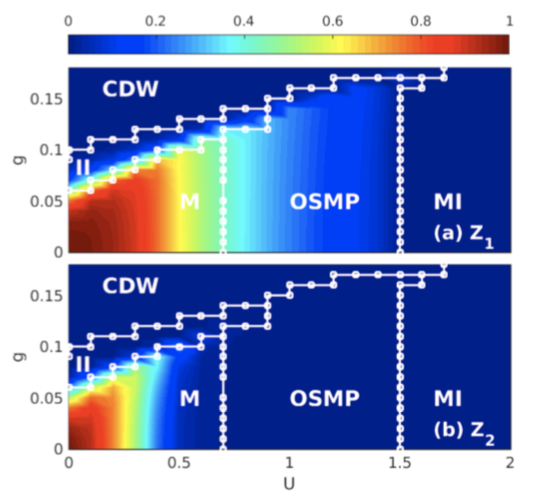 S. Li et al., PRB 95, 121122(R) (2017);
S. Li et al., PRB 97, 195116 (2017) —
Researchers have recently begun focusing on electron-electron interactions in multiorbital systems like the
Fe-based superconductors and discovered new phenomena like the orbital-selective Mott phase (OSMP). While these concepts have shaped
our understanding of the enigmatic properties of these materials, little is known about how competition/cooperation
with other factors like the electron-phonon (e-ph) interaction influences them. Here, we studied multi-orbital Hubbard-Holstein models
using DMFT and DQMC. We found that the e-ph interaction, even at weak couplings, strongly modifies the phase diagrams of these models
and introduces an orbital-selective Peierls insulating phase (OSPI) that is analogous to the widely studied OSMP.
S. Li et al., PRB 95, 121122(R) (2017);
S. Li et al., PRB 97, 195116 (2017) —
Researchers have recently begun focusing on electron-electron interactions in multiorbital systems like the
Fe-based superconductors and discovered new phenomena like the orbital-selective Mott phase (OSMP). While these concepts have shaped
our understanding of the enigmatic properties of these materials, little is known about how competition/cooperation
with other factors like the electron-phonon (e-ph) interaction influences them. Here, we studied multi-orbital Hubbard-Holstein models
using DMFT and DQMC. We found that the e-ph interaction, even at weak couplings, strongly modifies the phase diagrams of these models
and introduces an orbital-selective Peierls insulating phase (OSPI) that is analogous to the widely studied OSMP.
Dynamics of quantum spin ladders
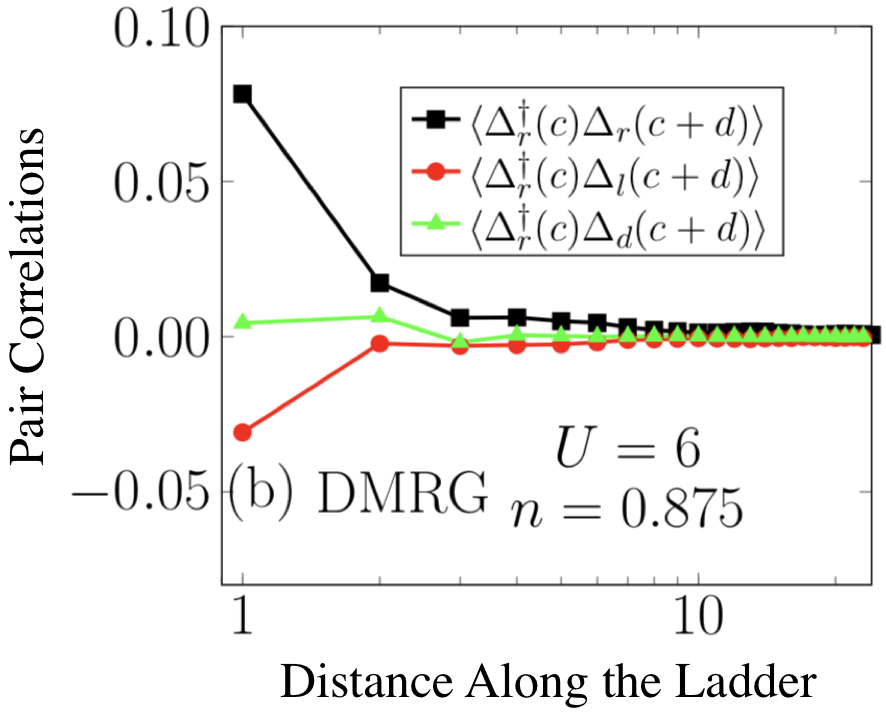 U.
Kumar et al., PRB 99, 205130 (2019);
A. Nocera et al., PRB 97, 195156 (2018) —
Strongly correlated spin ladders are excellent platforms for studying quantum many-body phenomena such as high-Tc superconductivity.
Recently, we have studied the dynamics of doped and undoped quantum spin ladders using multiple numerical and analytical methods. In doing so,
we have provided detailed predictions for the spin and charge dynamical structure factors, as well as the resonant inelastic x-ray scattering
intensity at the Cu L-edge. These studies provide a roadmap for future studies of the dynamical properties of spin ladders and their
connection to unconventional superconductivity.
U.
Kumar et al., PRB 99, 205130 (2019);
A. Nocera et al., PRB 97, 195156 (2018) —
Strongly correlated spin ladders are excellent platforms for studying quantum many-body phenomena such as high-Tc superconductivity.
Recently, we have studied the dynamics of doped and undoped quantum spin ladders using multiple numerical and analytical methods. In doing so,
we have provided detailed predictions for the spin and charge dynamical structure factors, as well as the resonant inelastic x-ray scattering
intensity at the Cu L-edge. These studies provide a roadmap for future studies of the dynamical properties of spin ladders and their
connection to unconventional superconductivity.
Non-linear electron-lattice interactions
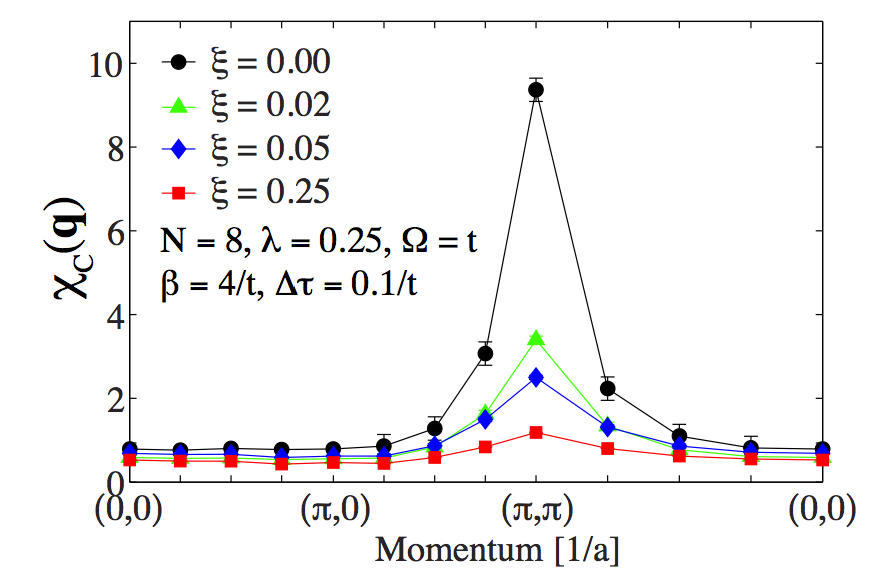 S. Li et
al. EPL 109, 27007 (2015) — Most models for electron-phonon
interactions rely on linear models, where the electronic
degrees of freedom couple to the linear lattice dispaclement.
In this work, we examined nonlinear electron-phonon interactions, which are expected when
the atomic displacments are large. We found additional nonlinear terms
significantly alter the charge-density-wave and superconducting ordering
tendencies predicted by the model. For example, the figure shows the CDW susceptibility for the
half-filled Holstein model with linear and quadratic e-ph interactions.
Here, we find that the CDW correlations predicted by the linear model are rapidly
suppressed small quadratic interactions. Also see
S. Li et al. PRB 92,
064301 (2015) and
P. M. Dee et al Communications Physics, 3 45
(2022).
S. Li et
al. EPL 109, 27007 (2015) — Most models for electron-phonon
interactions rely on linear models, where the electronic
degrees of freedom couple to the linear lattice dispaclement.
In this work, we examined nonlinear electron-phonon interactions, which are expected when
the atomic displacments are large. We found additional nonlinear terms
significantly alter the charge-density-wave and superconducting ordering
tendencies predicted by the model. For example, the figure shows the CDW susceptibility for the
half-filled Holstein model with linear and quadratic e-ph interactions.
Here, we find that the CDW correlations predicted by the linear model are rapidly
suppressed small quadratic interactions. Also see
S. Li et al. PRB 92,
064301 (2015) and
P. M. Dee et al Communications Physics, 3 45
(2022).